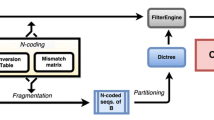Abstract
In this paper, we studied the MINimum-d-Disjunct Submatrix (MIN-d-DS), which can be used to select the minimum number of non-unique probes for viruses identification. We prove that MIN-d-DS is NP-hard for any fixed d. Using d-disjunct matrix, we present an O(log k)-approximation algorithm where k is an upper bound on the maximum number of targets hybridized to a probe. We also present a (1+(d+1)log n)-approximation algorithm to identify at most d targets in the presence of experimental errors. Our approximation algorithms also yield a linear time complexity for the decoding algorithms.
Similar content being viewed by others
References
Borneman J, Chrobak M, Vedova GD, Figueroa A, Jiang T (2001) Probe selection algorithms with applications in the analysis of microbial communities. Bioinformatics 17(1):339–348
Du D-Z, Hwang FK (2006) Pooling designs: group testing in molecular biology. World Scientific, Singapore
Gao H, Hwang FK, Thai MT, Wu W, Znati T (2006) Construction of d(H)-disjunct matrix for group testing in hypergraphs. J Comb Optim 12(3):297–301
Klau GW, Rahmann S, Schliep A, Vingron M, Reinert K (2004) Optimal robust non-unique probe selection using integer linear programming. J Bioinform 20:186–193
Li Y, Thai MT, Liu Z, Wu W (2005) Protein-protein interaction and group testing in bipartite graphs. Int J Bioinform Res Appl 1(4):414–419
Moret BME, Shapiro HD (1985) On minimizing a set of tests. SIAM J Sci Statist Comput 6:983–1003
Rahmann MS (2002) Rapid large-scale oligonucleotide selection for microarrays. In: Proceedings of the first IEEE computer society bioinformatics conference (CSB), Stanford, pp 54–63
Rahmann S (2003) Fast and sensitive probe selection for DNA chips using jumps in matching statistics. In: Proceedings of the 2nd IEEE computational systems bioinformatics conference (CSB), Stanford, pp 57–64
Schliep A, Torney DC, Rahmann S (2003) Group testing with DNA chips: generating designs and decoding experiments. In: Proceedings of the computational systems bioinformatics (CSB’03)
Steinfath M, O’Brien J, Seidel H, Meier-Ewert S, Lehrach H, Radelof U (2000) Information theoretical probe selection for hybridization experiments. Bioinformatics 16(10):890–898
Thai MT, MacCallum D, Deng P, Wu W (2007a) Decoding algorithms in pooling designs with inhibitors and fault tolerance. Int J Bioinform Res Appl 3(2):145–152
Thai MT, Deng P, Wu W, Znati T (2007b) Approximation algorithms of non-unique probes selection for biological target identification. In: Proceedings of conference on data mining, systems analysis and optimization in biomedicine
Vazirani VV (2001) Approximation algorithms. Springer, New York
Wang X, Seed B (2003) Selection of oligonucleotide probes for protein coding sequences. Bioinformatics 19:796–802
Author information
Authors and Affiliations
Corresponding author
Additional information
The research of T. Znati was supported in part by National Science Foundation under grant CCF-0548895.
Rights and permissions
About this article
Cite this article
Thai, M.T., Znati, T. On the complexity and approximation of non-unique probe selection using d-disjunct matrix. J Comb Optim 17, 45–53 (2009). https://doi.org/10.1007/s10878-008-9188-3
Published:
Issue Date:
DOI: https://doi.org/10.1007/s10878-008-9188-3




